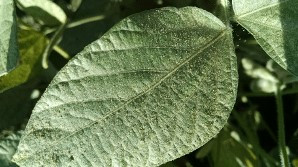By Jaime Cummings and Ken Wise et.al
Widespread drought conditions are stressing the crops, and may lead to flare ups of two-spotted spider mites in some soybean fields. We’ve already heard some reports of low to moderate spider mite infestations in a few fields in western NY, and could expect more in coming weeks if the weather stays hot and dry. If left unchecked, even a moderate infestation can result in 10-15% yield loss. As with any pest, it’s best to understand why they are problematic and what the best management practices are.

Two-spotted spider mites through magnifier
Spider mites are tiny, eight-legged critters that can spin webs like spiders. In fact, they spin little web parachutes to catch the wind and blow into your fields. They prefer hot, dry conditions, where they can reproduce rapidly with multiple generations completed every 7 – 21 days. Infestations typically start at field margins, usually in the lower canopy, but can quickly spread throughout a field. The spider mites are difficult to see individually with the naked eye, but their feeding causes obvious damage. Feeding injury results in stippling (or speckled-like) appearance of leaves, as the mites colonize and feed on the lower surfaces of soybean leaves. These speckles start out as almost a silver color, but later can turn yellow or brown. Severe feeding damage can cause entire leaves to become curled and necrotic, reducing photosynthesis, and potentially even resulting in death of severely affected plants. Webbing will be obvious on the underside of infested leaves, as may be the small, white shed skins from molting individuals. You can shake a damaged plant onto a piece of paper or hood of your vehicle to knock the mites off to see them. Check out this video of spider mite activity on a corn leaf by Mike Stanyard, CCE.

Spider mite damaged leaf with mites on webbing, and mites congregating at tip of leaf
The mites have piercing-sucking mouth parts, which penetrate the leaves and consume the plant sap, similar to how aphids feed. This makes things worse for the already drought-stressed plants. Damaged plants may be prematurely defoliated or stunted, resulting in fewer pods and fewer beans per pod. This can all happen very quickly when conditions are ripe for population explosions of this pest.

Soybean leaf heavily infested with spider mites
Spider mites are always present at low levels in crops and surrounding weeds or hedgerows. They are typically kept in check by natural populations of parasitic fungi and beneficial insects. Unfortunately, the hot, dry weather that favors spider mite outbreaks isn’t favorable for these naturally occurring biocontrol agents. Staying ahead of the pest by knowing when to expect them and keeping weedy field margins mowed to minimize reservoir habitats are a good way to start. The best and easiest way to manage spider mites is with persistent rainfall, but we can’t control the weather! Pay attention to the forecast, and if moderate moisture is predicted, you may be able to avoid taking other action. But, if the forecast is for continued hot and dry conditions, then you should scout your soybean fields weekly. There is no specific economic or action threshold for spider mites. Scouting to catch damage early and knowing the forecast will help you make the best decision on whether or not to spray. If you catch them early, you may be able to spray just the affected field margin and approximately the surrounding 100 feet to contain them. For small fields, you may need to treat the entire field. It’s important to know that none of the insecticides target the eggs, so there may be a resurgence following the first spray if there are many eggs present and if favorable conditions persist. Below is a table of registered insecticides labeled for spider mites in NY as of July 2020. Remember to read and follow all label instructions when using any pesticides.

Source : cornell.edu